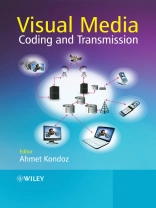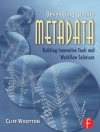This book presents the state-of-the-art in visual media coding
and transmission
Visual Media Coding and Transmission is an output of
VISNET II No E, which is an EC IST-FP6 collaborative research
project by twelve esteemed institutions from across Europe in the
fields of networked audiovisual systems and home platforms. The
authors provide information that will be essential for the future
study and development of visual media communications technologies.
The book contains details of video coding principles, which lead to
advanced video coding developments in the form of Scalable Coding,
Distributed Video Coding, Non-Normative Video Coding Tools and
Transform Based Multi-View Coding. Having detailed the latest work
in Visual Media Coding, networking aspects of Video Communication
is detailed. Various Wireless Channel Models are presented to form
the basis for both link level quality of service (Qo S) and cross
network transmission of compressed visual data. Finally,
Context-Based Visual Media Content Adaptation is discussed with
some examples.
Key Features:
* Contains the latest advances in this important field covered
by VISNET II No E
* Addresses the latest multimedia signal processing and coding
algorithms
* Covers all important advance video coding techniques, scalable
and multiple description coding, distributed video coding and
non-normative tools
* Discusses visual media networking with various wireless
channel models
* Qo S methods by way of link adaptation techniques are detailed
with examples
* Presents a visual media content adaptation platform, which is
both context aware and digital rights management enabled
* Contains contributions from highly respected academic and
industrial organizations
Visual Media Coding and Transmission will benefit
researchers and engineers in the wireless communications and signal
processing fields. It will also be of interest to graduate and Ph D
students on media processing, coding and communications
courses.
विषयसूची
VISNET II Researchers.
Preface.
Glossary of Abbreviations.
1 Introduction.
2 Video Coding Principles.
2.1 Introduction.
2.2 Redundancy in Video Signals.
2.3 Fundamentals of Video Compression.
2.4 Advanced Video Compression Techniques.
2.5 Video Codec Standards.
2.6 Assessment of Video Quality.
2.7 Conclusions.
References.
3 Scalable Video Coding.
3.1 Introduction.
3.2 Overview of the State of the Art.
3.3 Scalable Video Coding Techniques.
3.4 Error Robustness for Scalable Video and Image Coding.
3.5 Conclusions.
References.
4 Distributed Video Coding.
4.1 Introduction.
4.2 Distributed Source Coding.
4.3 Stopping Criteria for a Feedback Channel-based Transform Domain Wyner-Ziv Video Codec.
4.4 Rate-distortion Analysis of Motion-compensated Interpolationat the Decoder in Distributed Video Coding.
4.5 Nonlinear Quantization Technique for Distributed Video Coding.
4.6 Symmetric Distributed Coding of Stereo Video Sequences.
4.7 Studying Error-resilience Performance for a Feedback Channel-based Transform Domain Wyner-Ziv Video Codec.
4.8 Modeling the DVC Decoder for Error-prone Wireless Channels.
4.9 Error Concealment Using a DVC Approach for Video Streaming Applications.
4.10 Conclusions.
References.
5 Non-normative Video Coding Tools.
5.1 Introduction.
5.2 Overview of the State of the Art.
5.3 Rate Control Architecture for Joint MVS Encoding and Transcoding.
5.4 Bit Allocation and Buffer Control for MVS Encoding Rate Control.
5.5 Optimal Rate Allocation for H.264/AVC Joint MVSTranscoding.
5.6 Spatio-temporal Scene-level Error Concealment for Segmented Video.
5.7 An Integrated Error-resilient Object-based Video Coding Architecture.
5.8 A Robust FMO Scheme for H.264/AVC Video Transcoding.
5.9 Conclusions.
References.
6 Transform-based Multi-view Video Coding.
6.1 Introduction.
6.2 MVC Encoder Complexity Reduction using a Multi-grid Pyramidal Approach.
6.3 Inter-view Prediction using Reconstructed Disparity Information.
6.4 Multi-view Coding via Virtual View Generation.
6.5 Low-delay Random View Access in Multi-view Coding Using a Bit Rate-adaptive Downsampling Approach.
References.
7 Introduction to Multimedia Communications.
7.1 Introduction.
7.2 State of the Art: Wireless Multimedia Communications.
7.3 Conclusions.
References.
8 Wireless Channel Models.
8.1 Introduction.
8.2 GPRS/EGPRS Channel Simulator.
8.3 UMTS Channel Simulator.
8.4 Wi MAX IEEE 802.16e Modeling.
8.5 Conclusions.
References.
9 Enhancement Schemes for Multimedia Transmission over Wireless Networks.
9.1 Introduction.
9.2 Link-level Quality Adaptation Techniques.
9.3 Link Adaptation for Video Services.
9.4 User-centric Radio Resource Management in UTRAN.
9.5 Conclusions.
References.
10 Quality Optimization for Cross-network Media Communications.
10.1 Introduction.
10.2 Generic Inter-networked Qo S-optimization Infrastructure.
10.3 Implementation of a Qo S-optimized Inter-networked Emulator.
10.4 Performances of Video Transmission in Inter-networked Systems.
10.5 Conclusions.
References.
11 Context-based Visual Media Content Adaptation.
11.1 Introduction.
11.2 Overview of the State of the Art in Context-aware Content Adaptation.
11.3 Other Standardization Efforts by the IETF and W3C.
11.4 Summary of Standardization Activities.
11.5 Generation of Contextual Information and Profiling.
11.6 The Application Scenario for Context-based Adaptation of Governed Media Contents.
11.7 Conclusions.
References.
Index.
लेखक के बारे में
Professor Ahmet Kondoz, University of Surrey, Guildford
Professor Kondoz is a Deputy Director in the Centre for Communication Systems Research (CCSR) at the University of Surrey. His current research interests are low bit rate speech, image and video coding error resilient video transmission, mobile multimedia communications, robust wireless ATM, real-time terminal design and implementation for mobile communications. He is the author/co-author of more than 130 publications. His book entitled DIGITAL SPEECH: Coding for Low Bit Rate Communication Systems published by John Wiley & sons in 1994 has been accepted as a standard text in low bit rate speech coding by many engineers and universities.












